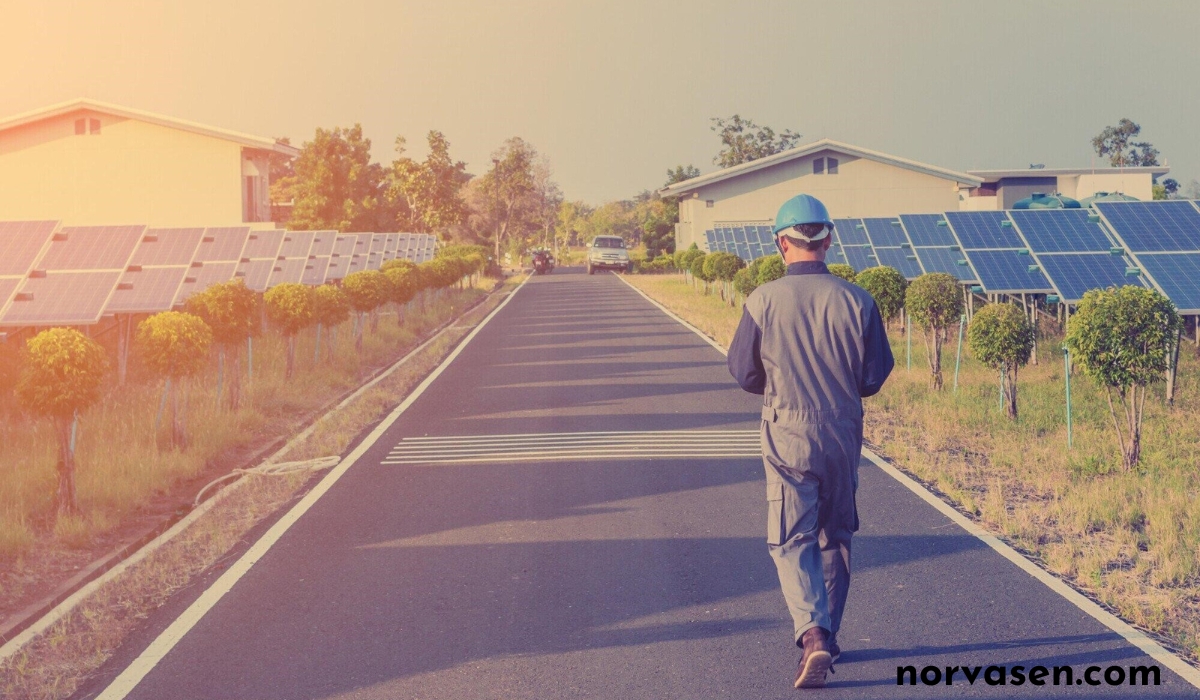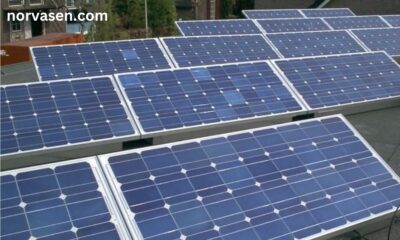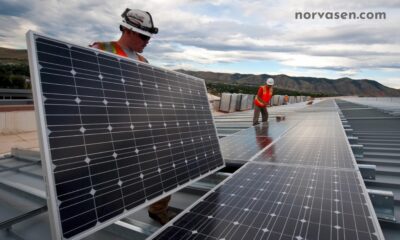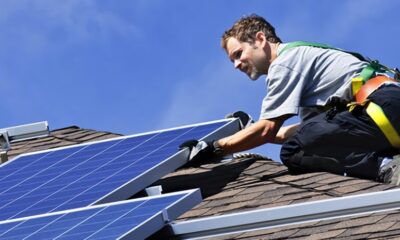Home Improvement
Maximizing Your Home’s Energy Efficiency with Backyard Solar Panels

The push towards sustainable living has seen a surge in the popularity of home solar panel installations. But for many, the traditional image of solar panels plastered across rooftops can be a turnoff. Some, are due to aesthetic concerns, some due to physical limitations of the home’s design.
Thus, an emerging trend in the green energy sector targets these concerns head-on – backyard solar panels. These compact, ground-mounted arrays offer flexibility, efficiency, and sometimes cost savings that can be more appealing for certain homeowners.
So here’s how you can harness the sun’s energy in your backyard:
Assess Your Solar Potential
Before jumping into installing backyard solar panels, it’s important to assess your home’s solar potential. You need to consider different factors as they can impact the efficiency of a solar panel:
Size of Your Property
The size of your property is a crucial factor when considering backyard solar panels. Larger properties have more space to accommodate solar installations. This can be spread out to maximize exposure to sunlight.
However, even smaller yards can benefit from solar panels. This is as long as they are strategically placed to optimize sunlight absorption.
It’s not just about the total area available. It’s also about assessing the most efficient layout for your solar panels. This can ensure they receive ample sunlight throughout the day.
It might involve clearing obstacles or considering innovative mounting solutions to angle panels. Remember, the goal is to capture as much sunlight as possible, translating to more generated electricity.
Orientation Towards the Sun
The orientation of your backyard towards the sun plays a pivotal role in determining the efficiency of your solar panel system. Ideally, solar panels should face south in the Northern Hemisphere. This will help capture the maximum amount of sunlight throughout the day.
However, this is not a strict requirement. Panels can still be efficient when facing east or west, albeit with slightly reduced exposure.
For homeowners with yards that don’t have a favorable south-facing orientation, adjustments can be made. Technologies like adjustable mounts allow panels to tilt toward the optimal angle. They catch more sunlight even in less-than-ideal conditions.
It’s also crucial to monitor the path of the sun across different seasons, as the sun’s position in the sky changes. This affects how much sunlight hits your panels.
Shading From Nearby Trees or Buildings
Shading from nearby trees or buildings can significantly impact the efficiency of your solar panels. Even partial shading can reduce the amount of electricity generated. This is because solar panels operate as a network, and when one panel is shaded, it can affect the output of the entire system.
Therefore, it’s essential to evaluate the location of your panels carefully. You need to take into account the potential for shading at different times of the day and year.
Strategically pruning trees in areas less likely to be affected by shadows can mitigate this issue. Some modern residential solar panels are equipped with microinverters or power optimizers. These devices allow each panel to operate independently. They reduce the impact of shading on overall system performance.
One way to determine your solar potential is by using an online solar calculator. These tools take into account your location, roof size, and electricity usage. They estimate the number of panels you may need and how much energy they can produce.
Alternatively, you can also consult with a professional solar panel installer. You can go to Blue Raven Solar and have them do a site evaluation to determine the ideal placement and number of panels for your backyard. They will be able to assess your property in person and provide a more accurate assessment of your solar potential.
Select the Right Solar Panel Type
Once you’ve assessed your solar potential, it’s time to select the right solar panel type for your backyard. There are various types of solar panels available on the market, each with its advantages and disadvantages.
Monocrystalline Panels
Monocrystalline panels are made from a single crystal of silicon. They are considered one of the most efficient and longest-lasting solar panels on the market. They have a sleek black appearance and are ideal for homeowners looking for an aesthetically pleasing option.
However, they can be more expensive compared to other types of solar panels. They’re also less efficient in extreme heat or partial shading conditions.
Polycrystalline Panels
Polycrystalline panels are made from multiple fragments of silicon melted together. They have a bluish tint and are generally more affordable than monocrystalline panels.
However, they tend to be slightly less efficient compared to monocrystalline panels. They also take up more space, so if you have limited backyard space, this might not be the best option for you.
Thin-Film Panels
Thin-film panels are made from a thin layer of semiconductor material, making them the lightest and most flexible option. They can be easier to install and may even be used on unconventional surfaces like curved roofs.
However, they also have the lowest efficiency among the different types of solar panels. They require more space compared to monocrystalline or polycrystalline panels. So you need to make sure you have the space to accommodate them.
Consider Battery Storage
An essential component of your backyard solar panel system is energy storage. This is where battery storage comes into play.
By integrating battery storage into the system, you ensure that the excess energy produced during peak sunlight hours doesn’t go to waste. Instead, it’s stored for use during times when the sun isn’t shining.
Battery storage systems are crucial for maximizing the use of your solar panels. Without them, you’re solely dependent on the grid for power when your panels aren’t producing energy. This can be especially problematic during power outages or peak demand times when electricity prices are highest.
Here are the battery storage options you can consider:
Lead Acid
Lead-acid batteries are the most commonly used type of battery for solar energy storage. They have been in use for decades and are known for their reliability and low cost.
However, they require regular maintenance. They can be heavy and bulky, They may not last as long as other types of batteries.
Lithium-Ion
Lithium-ion batteries are another popular option for solar storage. They’re lightweight and compact, making them ideal for backyard installations.
They have a longer lifespan compared to lead-acid batteries. However, they can be more expensive upfront.
Saltwater
Saltwater batteries are relatively new to the market but are gaining popularity due to their sustainability and eco-friendliness. They use salt water as an electrolyte instead of toxic chemicals, making them safer for the environment.
However, they have a lower energy density compared to other battery types. This means you may need more batteries to store the same amount of energy. They’re also more expensive upfront compared to traditional lead-acid batteries.
Decide Between On-Grid vs Off-Grid Systems
When considering backyard solar installations, you also need to decide between an on-grid or off-grid system.
On-Grid Systems
On-grid systems are connected to the utility grid and allow you to sell excess energy back to the grid. This means you can receive credits for any surplus electricity your panels produce.
However, on-grid systems do not provide backup power during power outages. They also require a net metering agreement with your utility company.
Off-Grid Systems
Off-grid systems are not connected to the utility grid, making you entirely self-sufficient. They use battery storage to power your home when there’s no sunlight.
However, they can be more expensive upfront and require regular maintenance. They also necessitate a larger battery bank to meet energy demands during extended periods of cloudy weather.
Government Incentives and Solar Rebates
The government offers various incentives and rebates to encourage people to switch to solar energy. These can significantly offset the cost of installing a backyard solar panel system.
Some common incentives include:
Solar Investment Tax Credit (ITC)
The Solar Investment Tax Credit (ITC) is a critical federal policy mechanism to support the growth of solar energy in the United States. The ITC allows homeowners, businesses, and utility-scale projects to deduct a portion of their installation costs from their federal taxes.
Net Metering
Net metering allows homeowners to receive credits on their utility bills for any excess energy produced by their panels. This means you can save money on your electricity bill even when you’re not using all the power generated by your solar panels.
Solar Renewable Energy Certificates (SRECs)
Some states have SREC programs that allow homeowners to sell the renewable energy credits their solar panels generate. This can provide additional income for homeowners with backyard solar panel installations.
State-Specific Incentives and Grants
Many states offer solar incentives and grants that go beyond federal programs. These can include upfront rebates to reduce the installation cost. It can also include property tax exemptions that prevent your property taxes from increasing.
The availability and specifics of these incentives vary greatly from one state to another. So it is essential to check with your local government or energy office.
Feed-in Tariffs
Feed-in Tariffs (FITs) are another form of incentive, though less common in the United States. Under a FIT program, the electric utility companies pay you for the electricity generated by your solar panels at a fixed rate. This is usually higher than the standard electricity rate.
This type of system not only provides earnings over time. It also encourages the adoption of renewable energy sources.
Consider DIY Solar Installation
If you have the skills and time, a DIY solar installation can save you a significant amount of money. There are solar panel kits available that come with everything you need to set up a basic solar system.
Keep in mind that installing a solar panel system can be complex. It involves working with high voltages and should adhere to local building codes.
If you’re not confident in your ability, it’s best to hire a professional solar installer. They can ensure your system is safely and accurately installed.
Maximize Your Home’s Aesthetic Appeal
One of the biggest concerns with traditional rooftop solar panels is their impact on a home’s aesthetic appeal. However, with backyard solar panel installations, you have more room to get creative.
Backyard solar panels can be integrated into your landscaping design. You can disguise it as part of your outdoor furniture. You can also choose from various color options and different mounting systems. This way, you can ensure that your source of renewable energy complements your home’s exterior.
Another way is to invest in premium solar panels that have a sleek, all-black design. These panels blend seamlessly into any backyard setting. They provide a more attractive alternative to traditional blue or silver panels.
Integrate Smart Energy Management Systems
You can now integrate smart energy management systems into your backyard solar installations. These systems allow for remote monitoring and control of your energy usage.
They can also provide insights on how to optimize your energy consumption and save money in the long run. For example, you can set up schedules for when certain appliances will turn on or off based on your solar production.
Smart energy management systems also allow for integration with other smart home devices. This further maximizes your home energy efficiency. This includes features like voice control, automated lighting, and temperature controls.
Educate Yourself on Maintenance and Care
Finally, it’s crucial to educate yourself on the maintenance and care of your backyard solar panel system. This includes regular cleaning to remove dirt or debris that may reduce efficiency. It also involves monitoring for any potential issues with panels, wiring, or batteries.
Most importantly, make sure to follow all safety precautions when working with a solar panel system. If you notice any abnormalities or concerns, consult with a professional solar installer.
A professional will also be able to provide you with tips on how to maximize the lifespan and efficiency of your panels. They can advise on when it’s time to replace certain components and help troubleshoot any issues that may arise.
Backyard Solar Panels: A Sustainable Investment
Installing backyard solar panels is not only a sustainable choice for powering your home. It’s also a wise investment that can save you money and potentially increase the value of your property.
With the right planning, you can enjoy a cleaner, more efficient home that also has environmental benefits. So why not make the switch to solar energy today? There’s no better time than now to take advantage of all the benefits that backyard solar panel installations have to offer.
Did you find this article helpful? If so, check out the rest of our site for more.
Home Improvement
Reasons to Hire Professional Junk Removal for Your Home Renovation

Embarking on a home renovation project can be an exhilarating yet daunting process, with many homeowners overlooking the inevitable accumulation of debris and unwanted materials. Efficient junk removal is a crucial component of a successful renovation, ensuring your work area is safe and clutter-free. Whether tearing down walls or updating fixtures, the waste generated can quickly become overwhelming. Professional junk removal companies provide the necessary means to keep your renovation organized and on track. Below, we explore the benefits of enlisting expert services for your home cleanout tasks.
Ensuring Safety and Compliance with Professional Junk Removal
Renovation projects can create hazardous environments if waste is not managed properly. Sharp debris, heavy materials, and potentially dangerous substances all pose serious safety risks. Hiring professionals for junk removal ensures these threats are handled correctly, reducing the chance of accidents or injuries.
Beyond safety, proper disposal is essential to stay compliant with local laws. Companies offering junk removal in Fort Collins, CO, are familiar with state and municipal regulations, use the right equipment and techniques to remove waste responsibly. Their services reflect a strong commitment to both safety and environmental care.
The Importance of Efficient Debris and Junk Removal During Home Renovations
Home renovations often produce large amounts of waste, including construction debris, old appliances, and personal items. If not properly managed, this clutter can hinder workflow, delay progress, and create safety hazards for contractors. Maintaining a clean and organized site is key to keeping renovations efficient and on schedule.
Professional junk removal services play a vital role by regularly clearing debris, allowing work to continue without interruption. These services also sort materials for recycling or donation, minimizing environmental impact. For homeowners, handling debris alone can be overwhelming and time-consuming, making professional help a practical choice that eases the burden and supports a smoother renovation process.
Streamlining Your Renovation Project with Professional Junk Hauling Services
Integrating professional junk hauling services into a renovation plan helps streamline operations by allowing construction teams to concentrate on building tasks without the distraction of waste removal. These services bring the necessary equipment and expertise to handle heavy or awkward debris efficiently, reducing strain on renovation crews.
A structured disposal approach also aids in cost control, as many companies provide upfront pricing based on volume or material type, helping homeowners avoid unexpected expenses. Junk removal teams ensure safe, efficient handling of discarded materials, maintaining workflow and project timelines. Their involvement supports a cleaner, safer site and allows homeowners to focus on design choices rather than logistics.
Enhancing Your Home’s Aesthetics and Value through Expert Cleanout Solutions
A clean, well-maintained renovation site significantly enhances both the visual appeal and efficiency of a project. Clutter and debris not only disrupt progress but also diminish the workspace’s appearance. Professional junk removal services help maintain order by promptly clearing waste, highlighting the renovation’s progress.
The property’s exterior also benefits, as a tidy environment boosts curb appeal and suggests careful project management, positively influencing perceived value. Removing old or unused items creates more functional space, making it easier to plan and implement design changes. This organized approach also supports long-term upkeep by encouraging homeowners to maintain a clean and well-managed space beyond the renovation phase.
Choosing the Right Junk Removal Company for Your Renovation Needs
Choosing the right junk removal service during a renovation requires careful consideration. Research a company’s experience, customer feedback, and whether they specialize in construction debris, as this can lead to better service tailored to renovation needs. Look for providers with clear pricing and free on-site estimates to avoid unexpected charges.
Evaluate their environmental practices; companies that focus on recycling and donation over dumping contribute positively to sustainability. It’s also important to assess their availability and flexibility, since renovation schedules often change. A provider that can adapt and offer prompt service helps keep the project on track without unnecessary delays.
Altogether, hiring a professional junk removal service for your home renovation project delivers numerous advantages, ranging from enhanced safety and efficiency to compliance and aesthetics. By selecting the right service provider, homeowners can streamline their renovation process and achieve a clutter-free, valuable outcome for their property.
READ ALSO: Save Time and Stress: The Advantage of Professional Junk Removal
Home Improvement
How Junk Removal Services Can Help with Home Renovations

Embarking on a home renovation can be an exhilarating endeavor that breathes new life into your living space. Amidst the excitement and planning, the accumulation of debris and old materials can become an overwhelming byproduct. Fortunately, professional junk removal services play a crucial role in maintaining the cleanliness and organization necessary for a successful renovation. They efficiently strip away the clutter, enabling homeowners to focus on the transformative process. Below, we’ll explore how these services can be integral to your next home improvement project.
Maximizing Space and Minimizing Stress: The Benefits of Professional Junk Hauling
Junk hauling services play a vital role in streamlining home renovations. By clearing out old fixtures, furniture, and debris, they free up valuable space needed for contractors and designers to work efficiently. This space optimization helps keep the renovation on track and allows the vision to take shape without clutter getting in the way.
Beyond just clearing space, professional junk removal in Austin, TX, can ease the emotional and financial strain on homeowners. Quick debris removal reduces stress, speeds up the renovation timeline, and often proves more cost-effective than DIY disposal. With less mess and more progress, homeowners can get back to enjoying their space sooner.
The Role of Junk Removal in Streamlining Home Renovation Projects
Junk removal services are essential during home renovations, helping to maintain a clean worksite and keep the project on schedule. They handle bulky items like old appliances and cabinetry, reducing physical strain on homeowners and renovation teams. These professionals also handle hazardous materials like asbestos or lead-laced paint, adhering to best practices to protect health and ensure regulatory compliance.
The prompt removal of debris by a professional team is reassuring for homeowners, as they can trust their property will be treated with respect and renovation will proceed without unnecessary hindrances caused by accumulated debris. Trusting these professionals ensures a smooth and efficient renovation process.
Enhancing Safety and Efficiency During Renovations Through Debris Removal
Junk removal services are crucial for safety and efficiency on renovation sites, as they help remove hazards like sharp objects, nails, and splintered materials. This reduces the risk of accidents and injuries. Cluttered spaces can impede workflow and extend project timelines, but junk removal experts ensure workers can move freely, allowing for timely completion.
They can handle large-scale waste removal, ensuring no delays in waste management. Professional debris removal also maintains the property’s aesthetic, as it helps maintain neighborhood standards and property values.
How Junk Removal Services Complement Contractor Work on Home Renovation Sites
Contractors can improve the efficiency of home renovations by partnering with junk removal services. Contractors, skilled in construction, electrical work, and plumbing, can’t specialize in waste management. Hiring a junk removal service allows them to focus on their craft without being distracted by cleanup duties.
This synergy leads to a seamless transition from demolition to reconstruction. Junk removal services also offer flexibility, allowing them to adapt to unexpected challenges and changes in waste disposal needs. This ensures that waste is handled responsibly and in compliance with regulations, providing liability protection and avoiding potential penalties or fines.
Transforming Renovation Waste Into Opportunity: Recycling and Donation Options
Sustainability is a growing concern in various industries, including home renovation. Junk removal services help homeowners and contractors make eco-friendly disposal decisions by recycling materials like wood, metal, and plastics. They also offer the option to donate usable materials to local charities or non-profit organizations, promoting a cycle of reuse and sustainability.
Junk removal services often partner with recycling centers and donation facilities, providing transparency and a sense of participation in a healthier planet. By considering environmental and charitable options, junk removal becomes a statement of values, allowing homeowners and contractors to feel pride in repurposing renovation waste in meaningful ways.
Altogether, junk removal services offer indispensable benefits to home renovation projects by promoting efficiency, safety, and eco-responsibility. They not only facilitate the logistical aspects of a renovation but also contribute to the ethical disposal and recycling of materials.
You May Also Like: Save Time and Stress: The Advantage of Professional Junk Removal
Home Improvement
How Junk Removal Services Can Enhance Your Property’s Curb Appeal

First impressions are everything when it comes to real estate. The exterior of your home is the first thing potential buyers see, and its condition can significantly influence their perception of the property’s value. A cluttered yard or an exterior that’s littered with unwanted items can detract from the beauty of a home and even decrease its market value. Fortunately, one effective way to enhance curb appeal is by employing professional junk removal services.
Understanding the Impact of Curb Appeal on Property Value
Curb appeal is not just about aesthetics; it’s an essential factor in establishing property value. A well-maintained exterior signals to potential buyers that a property is cared for, thereby increasing its attractiveness and perceived worth. It’s the first opportunity to showcase the home’s inherent qualities and the homeowner’s attention to detail.
Landscaping, the state of the façade, the condition of the driveway, and the presence of trash or debris all contribute to a property’s curb appeal. When these elements are in disarray, they can suggest neglect and potentially lead to lower appraisal values. A visually appealing exterior is crucial in real estate as it can lead to a higher number of showings and stronger offers from prospective buyers.
Junk Haulers Dallas understands the market dynamics and how removing excess clutter can alter a buyer’s first impression. They can efficiently clear out unnecessary items, ensuring that a property’s exterior presents its best self to potential investors and the community at large.
Enhancing Landscaping and Garden Spaces through Debris Removal
Landscaping plays a vital role in enhancing a home’s curb appeal. However, overgrown gardens, fallen limbs, and scattered yard waste can overshadow the most stunning landscape designs. By removing this debris, homeowners can reveal the true potential of their garden spaces, enabling plants and design features to become prominent.
Junk removal services can aid in turning cluttered and unkempt gardens into tranquil, inviting spaces. The removal of unwanted items provides room for new plants to thrive and can make ongoing garden maintenance significantly more manageable. Clearing away old garden furniture and broken planters also contributes to this transformation, creating a more appealing outdoor environment.
Many homeowners also utilize their gardens and yards for entertainment. A debris-free landscape can enhance the functionality of these areas, making them more conducive for gatherings and relaxation. Uninterrupted lawn spaces and clear garden paths add to the accessibility and enjoyment of outdoor living.
The Visual Benefits of Decluttering Driveways and Walkways
The condition of driveways and walkways significantly affects the overall look of a property. Accumulated items such as old cars, unused tools, and miscellaneous clutter not only restrict movement but also create a sense of disorder. Junk removal services provide a remedy, decluttering these areas to improve the visual flow and accessibility of the home’s exterior.
A decluttered driveway offers a welcoming approach to the home and can convey a sense of spaciousness. Ensuring these pathways are clear can also reduce the risk of accidents and improve the functionality of the space, allowing for smooth ingress and egress for vehicles and pedestrians alike.
Similarly, walkways and sidewalks are integral to the curb appeal of a home. When free from clutter, they guide visitors to the entrance of the home in a manner that is both attractive and safe. Junk removal services can assist with clearing out any obstructions, highlighting the intentional design of pathways, and contributing to the overall cohesion of the landscape.
Increasing Homebuyer Interest With a Junk-Free Property Presentation
A home’s presentation can make or break a buyer’s interest. As real estate markets become ever more competitive, the need to present a property in its best light becomes paramount. Clearing a property of junk can significantly influence a buyer’s opinion, making them more likely to consider purchasing.
When a property is clutter-free, it becomes easier for potential buyers to visualize themselves living there. Junk removal services enable sellers to present a blank canvas, thereby allowing individuals the chance to project their own ideas and preferences onto the space. This personal connection can be a critical element in closing a sale.
Overall, investing in junk removal services is an essential step towards enhancing the curb appeal of a property. It allows homeowners to present a clean and attractive exterior, boosting the potential value of their home and igniting the interest of potential buyers. Altogether, this simple service can yield immense benefits for homeowners looking to improve their property’s marketability.
-

 Education10 months ago
Education10 months agoMastering Excel: Your Comprehensive Guide To Spreadsheets And Data Analysis
-

 Tech1 year ago
Tech1 year agoHow To Choose The Best Forex Trading Broker?
-

 Business1 year ago
Business1 year agoExploring the Rental Market: Properties for Rent in Malta
-

 Blog11 months ago
Blog11 months agoArab MMA Fighters Shine Bright: Meet the Champions of PFL MENA
-

 Travel1 year ago
Travel1 year agoExperience the Best Desert Safari Dubai Offers!
-

 How-To Guides1 year ago
How-To Guides1 year agoComprehensive Guide to Cockwarming: Enhancing Intimacy and Connection
-

 Home Improvement2 years ago
Home Improvement2 years agoEco-Friendly Round Rug Options for Sustainable Living in NZ
-

 Apps and Games2 years ago
Apps and Games2 years agoDiscover Tickzoo: The Ultimate Platform for Video Content Lovers and Creators










